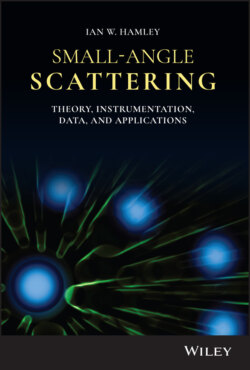Читать книгу Small-Angle Scattering - Ian W. Hamley - Страница 18
1.6.1 Analytical Expressions
ОглавлениеAnalytical expressions for structure factors are available for a few simple systems including spherical and cylindrical particles [17, 18] and lamellar structures. For spheres, the hard sphere structure factor is the simplest model, as the name suggests this structure factor is derived based on purely steric interactions between solid packed spheres (volume fraction ϕ and hard sphere radius RHS). It is written
(1.38)
Here
(1.39)
with
(1.40)
At q = 0, the Carnahan‐Starling closure to the hard sphere structure factor gives the expression [11, 19]
(1.41)
The sticky hard sphere potential allows for a simple attractive potential between spheres (the equation for the structure factor is presented elsewhere [17, 18]). For charged spherical particles, the screened Coulomb potential may be employed.
For cylinders, a random phase approximation (RPA, Section 1.8) equation may be used or the PRISM (polymer reference interaction site model, Section 5.8) structure factor. The RPA expression is
(1.42)
Here n is the number density of cylinders, ν is usually treated as a fit parameter and Pcyl(q) is the form factor of a cylinder of radius R and length L (see also Table 1.2):
(1.43)
Here J1(x) denotes a first order Bessel function.
Table 1.1 Sequences of Bragg reflections for common structures.
| Structure | Reflections | Positional ratio |
|---|---|---|
| Lamellar | (001),(002),(003),(004),(005),(006) | 1 : 2 : 3 : 4 : 5 : 6 |
| Hexagonal | (1,0),(1,1),(2,0),(2,1),(3,0),(2,2) | 1 : : : |
| Body‐centred cubic | (110),(200),(211),(220),(310),(222) | : : : |
| Face‐centred cubic | (111),(200),(220),(311),(222),(400) | : : : |
| Bicontinuous cubic Primitive cubic ‘plumber's nightmare’ | As above | As above |
| Bicontinuous cubic ‘double diamond’ | (110),(111),(200),(211),(220),(300) | : : : |
| Bicontinuous cubic ‘gyroid’ | (211),(220),(321),(400),(420),(332),(422) | : : : |
It is possible to compute ν from an equation for osmotic compressibility [17, 18]:
(1.44)
Here B = πR2Ln, C = 4πr3n/3, and D = πRL2/2, where n is the number density [17].
For lamellar or smectic structures a number of structure factors have been proposed, based on the fluctuations of the layers. Figure 1.6 illustrates the thermal fluctuations that arise from the flexibility of the layers in a lamellar system. These fluctuations destroy true long‐range order in all one‐dimensional systems according to the Landau‐Peierls instability [20].
Figure 1.6 Fluctuations in the layer positions in a lamellar structure that are characterized by the membrane stiffness.
The structure factor for a stack of N fluctuating layers can be written as [21]
(1.45)
The term σ is the width parameter in a Gaussian function
(1.46)
This is used to account for polydispersity in the number of layers and a suitable choice is for a sufficiently large N. In Eq. (1.45), Ndiff is a diffuse scattering term arising from uncorrelated fluctuations of layers.
Different models have been proposed to describe the thermal fluctuations and hence the structure factor terms Sk. In the thermal disorder model, each layer fluctuates with an amplitude Δ = 〈(dk − d)2〉, where d is the average lamellar spacing. The structure factor is that of an ideal one‐dimensional crystal multiplied by a Debye‐Waller factor:
(1.47)
In the second model, the paracrystalline model (this type of model is discussed further in Section 1.6.3), the position of an individual fluctuating layer in a paracrystal is determined solely by its nearest neighbours. Then [21, 22]
(1.48)
In a third alternative model, introduced by Caillé [23] and modified to allow for finite lamellar stacks [24, 25], the fluctuations are quantified in terms of the flexibility of the membranes:
(1.49)
Here γ is Euler's constant and
(1.50)
is the Caillé parameter, which depends on the bulk compression modulus B and the bending rigidity K of the layers.
